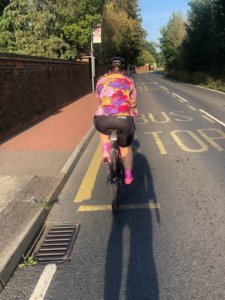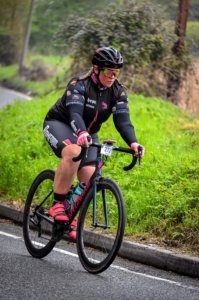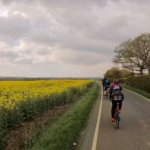I was cycling recently and one stretch of road had some truly awful road surface with so many holes, wide cracks and uneven surface on the left hand side where I would normally be positioned when riding. I had to indicate several times to move out to the right and thankfully the driver behind me was very patient and this was not an issue. Shortly after we came to a set of traffic lights and it was red so I stopped and the driver pulled up beside me. They politely asked why I kept moving out and so I explained that the holes and cracks that he could drive over in a car could have terrible consequences for a cyclist. He said that made sense and when the lights changed we both set off on our way.
Now don’t get me wrong there are some terrible cyclists out there, but there are also some terrible drivers so lets not tar everyone with the same brush as there could be a very plausible reason. There are so many things like what I outlined above, that I am sure are unknown to those who do not cycle and so I thought I would list a few and share why cyclists may behave differently on the road to a car user.
- Potholes – as mentioned earlier a hole that a vehicle could easily drive over could cause an accident with horrible consequences for a cyclist. This could cause punctures, bent wheels or cause a flip off the bike. You may see a cyclist move further out into the road, after indicating and when safe, to avoid such obstacles.
- Manhole covers – particularly dangerous when wet, especially on slick road tyres, as they can cause wheels the slide but also can be sunk into the ground and have the same effect as potholes so similar behaviour may be observed as mentioned above.
- Speed bumps – the same as a car driver, a cyclist needs to anticipate the obstacle whilst also checking the road surface on the other side so you may notice a cyclist lower their speed before going over speed bumps.
- Cycle paths – I commute on the CS3 and it is great to have a safe space to cycle that separates the car users and cyclists, however, if there are roadworks the signs are very often put in the cycle path. These paths are not cleaned that often either and more often than not end up with debris that can cause accidents and punctures. The surface can (as is the case on the CS3) be savage in winter when the wet and the result of cold weather such as icy surfaces can make bike handling particularly difficult. As per rule no 63 of the Highway Code it is not a legal requirement to use a cycle path so cyclists may choose not to do so, so you may see cyclists opt to ride in the road if it is the safer option to do so. The design speed on these paths is 12mph as per London Cycle Design Standards and a lot of cyclists will exceed this. cycle paths are also intermittent and will very rarely, if at all, take a cyclist from their start to end destination and this could be another reason they opt not to use them and instead use a different route.
- Railway crossings – same principle for cyclists as car users in that if barriers are down they must stop and wait and when riding across maintaining your line is key so wheels do not get caught and wedged on the tracks so you may find a cyclist may move out slightly to ensure they go over at the right angle. Cyclists may even need to dismount and walk across depending on the angle of the tracks for safety.
- Cattle grids – these are more common when cycling off road but I have had to cross these on a number of events and if I am honest they terrify me! Mostly the same principle as railway crossings apply, however, on some the gaps can be way too wide for a road bike and so you may see people choose to get off their bike and walk over to be safe.
- Cobbles – again super slippery when wet and depending on the gap between the cobbles, cyclists need to ensure they maintain momentum to avoid having an accident or fall. If a wheel were to jam between the gap the momentum you had up until that point would more than likely see you going over your handlebars. They may also increase the gear, which can slow the speed slightly but this is to ensure the chain does not slip.
- Traffic lights – same rules for all road users so if it is red then you stop and wait!! It is key for cyclists to be aware of vehicles on the road with them and vice versa especially when you may be travelling forward and a vehicle next to you may turn left across your path. Rule no 69 and 71 of the Highway Code cements that all traffic signals and signs are to be obeyed.
- Puddles – never trust them as a cyclist as you can’t see what is underneath! Much the same principle as potholes so you may see a cyclist indicate to move out to avoid it in the road and that is the reason why.
- Riding two abreast – in line with the Highway Code it is suggested to ride two abreast so there is a shorter distance for vehicles to overtake. This of course should be exercised with common sense and changed to single file especially in more urban areas, narrow roads and around corners.
- Road tax – that old favourite that cyclists don’t pay road tax, well neither do cars. It was abolished in the 1930’s and now emissions tax is paid and bikes have no emissions hence no fee required.
- It’s illegal to ride on the road – I have been told this by drivers a number of times and it is just incorrect. Rule no 64 of the Highway Code states that cyclists must not cycle on a pavement. Very often car users would prefer for cyclists to ride on the pavements and cyclists will wonder why other cyclists are riding on the pavements and not the road?!
- Hand signals – cyclists use a number of hand signals when riding with others. If you are not a cyclist you may drive behind one thinking what on earth are they doing. Mostly this is to indicate the direction they are going so other road users are aware, but it could also be to point out holes or obstacles, indicate if there is a car parked and they need to move out in the road, hold their hand up or pushing down gesture to signal stopping or slowing down, or gesture to vehicles behind that it is safe to overtake.
- Horses – cyclists should slow down if approaching a horse rider on the road and this should be done regardless of what direction you are approaching it. Cyclists should keep pedalling but slow down and not freewheel as the sound can scare the horse. They will pass carefully and wide.
- Parked cars – cyclists may allow ample space between them and a parked car just in case of opening car doors so you may notice cyclists move out further into the road as they pass parked cars and this is the reason why.
- Riding out of the gutter – it is believed that cyclists should be positioned right next to the gutter/pavement when on the road and most cyclists will position themselves to the left. However, cyclists are within their right to cycle on the road and the gutter is where debris collects and so it is often the safer choice to position yourself just outside of that so that is why you may see a cyclist choose to ride slightly further out in the road.
- Wind – the effect of wind on a cyclist can cause your position to shift especially if you are passing a gap in a hedge, for example, and a crosswind appears suddenly. As a cyclist I can honestly say my last wish is to be a hazard to other road users and involuntary movement is often scary but out of our control.
- Being visible – as a cyclist I prefer to be safe and seen and will always use adequate lights and reflective clothing when necessary. I do not want to assume another road user has seen me and this assists with that. Rule no 60 of the Highway Code states cyclist must have a white front light and red rear light lit.
- Bus lanes – if road signs indicate it is permitted then cyclists may use the bus lane. On my commute there is a busy road in London that I always opt to use the bike lane as it is safer and I ensure I pass any parked buses with care in case a pedestrian is walking in front.
As a cyclist I can honestly say I do not wish to hold up other road users at all. There is nothing worse than being on your bike knowing you are holding people up, especially if there is no obvious passing place or safe place to stop.
There are a number of resources available online on this matter as follows:
- Royal Society for Prevention of Accidents – Sharing the Road Together
- Highway Code – Code for Cyclists
- AA – How Drivers Can Share The Road With Cyclists
- A number of resources available for cycling guidance from British Cycling
Happy cycling, and driving! Let’s all share the road in a positive way.





Leave a Reply